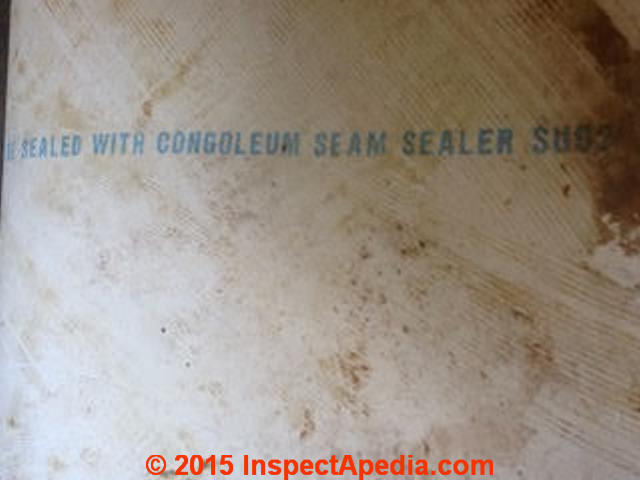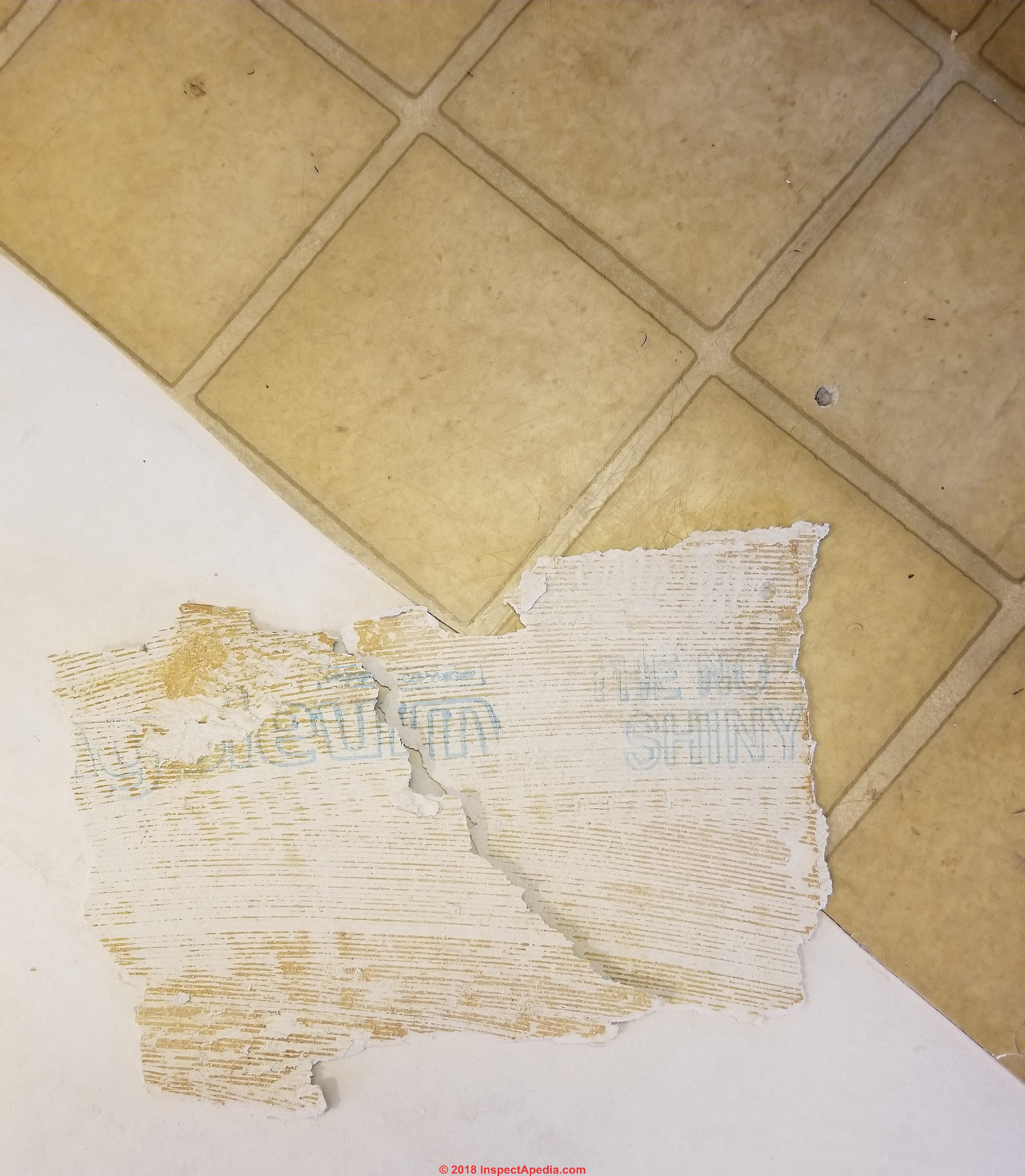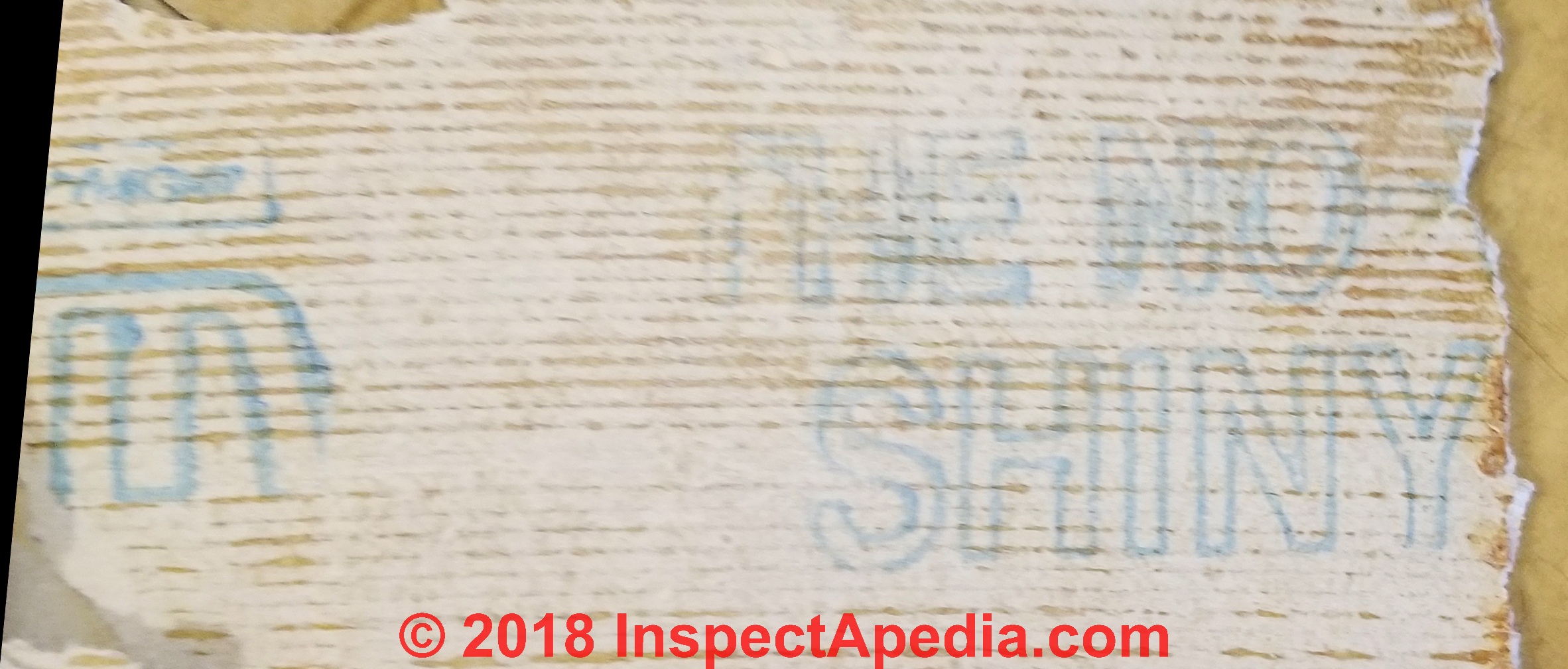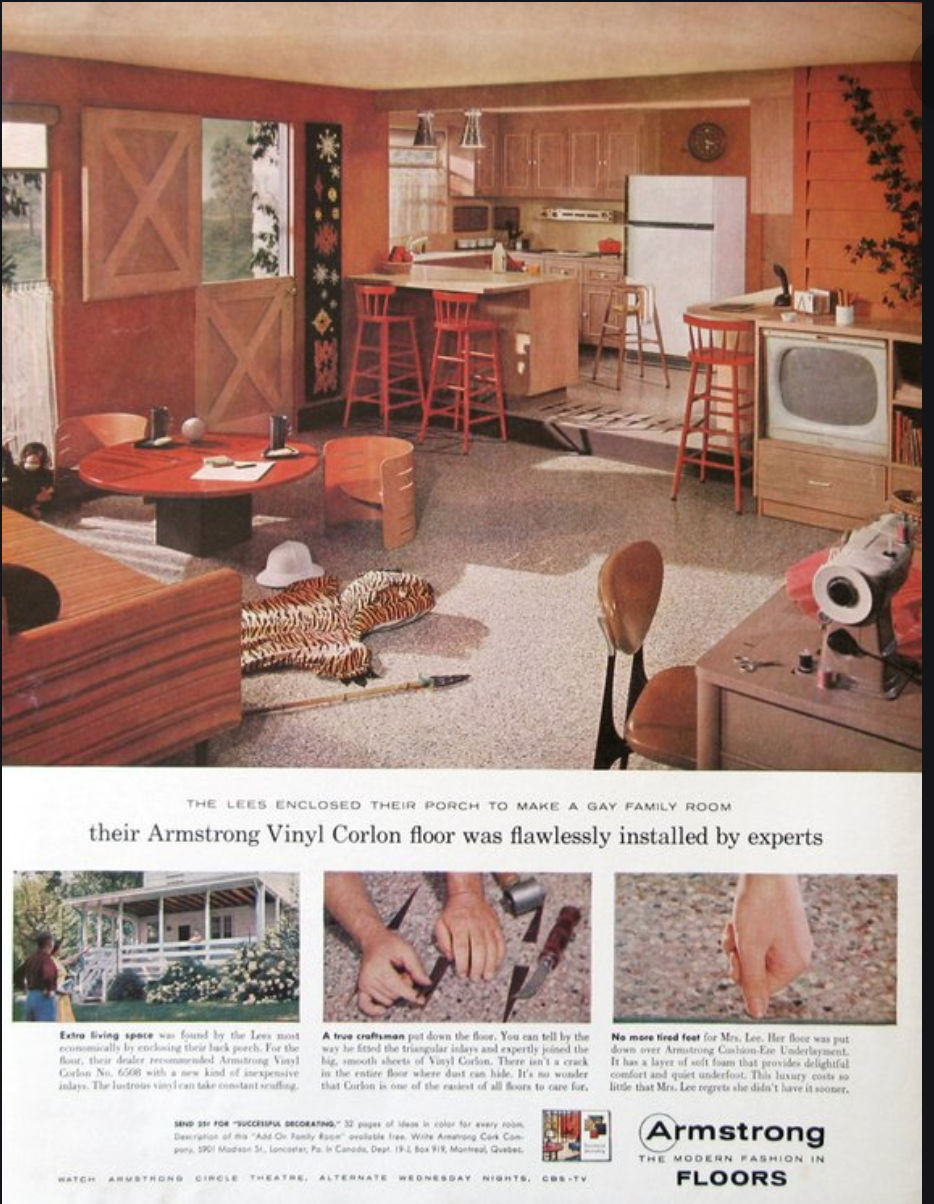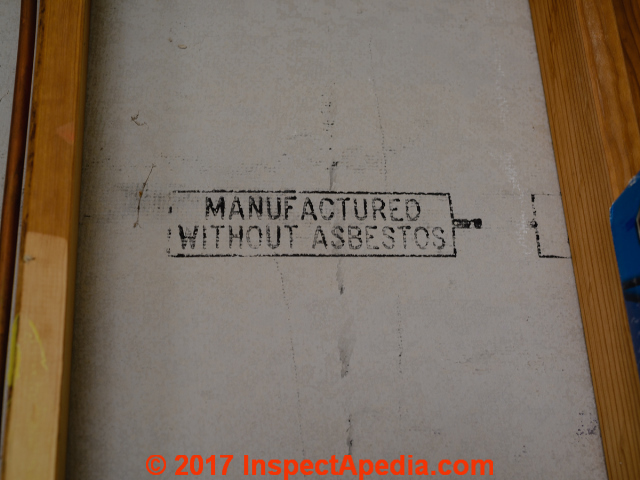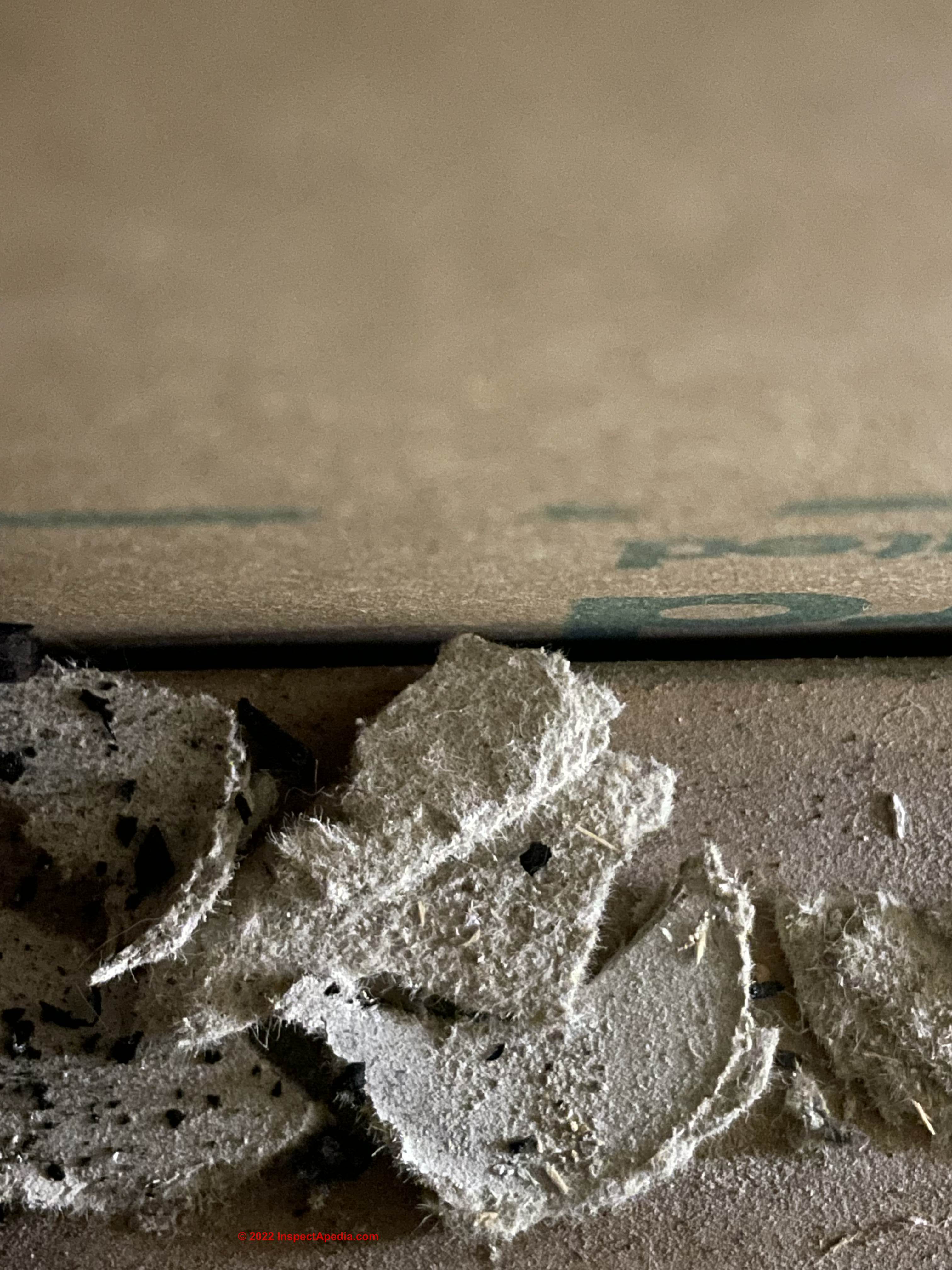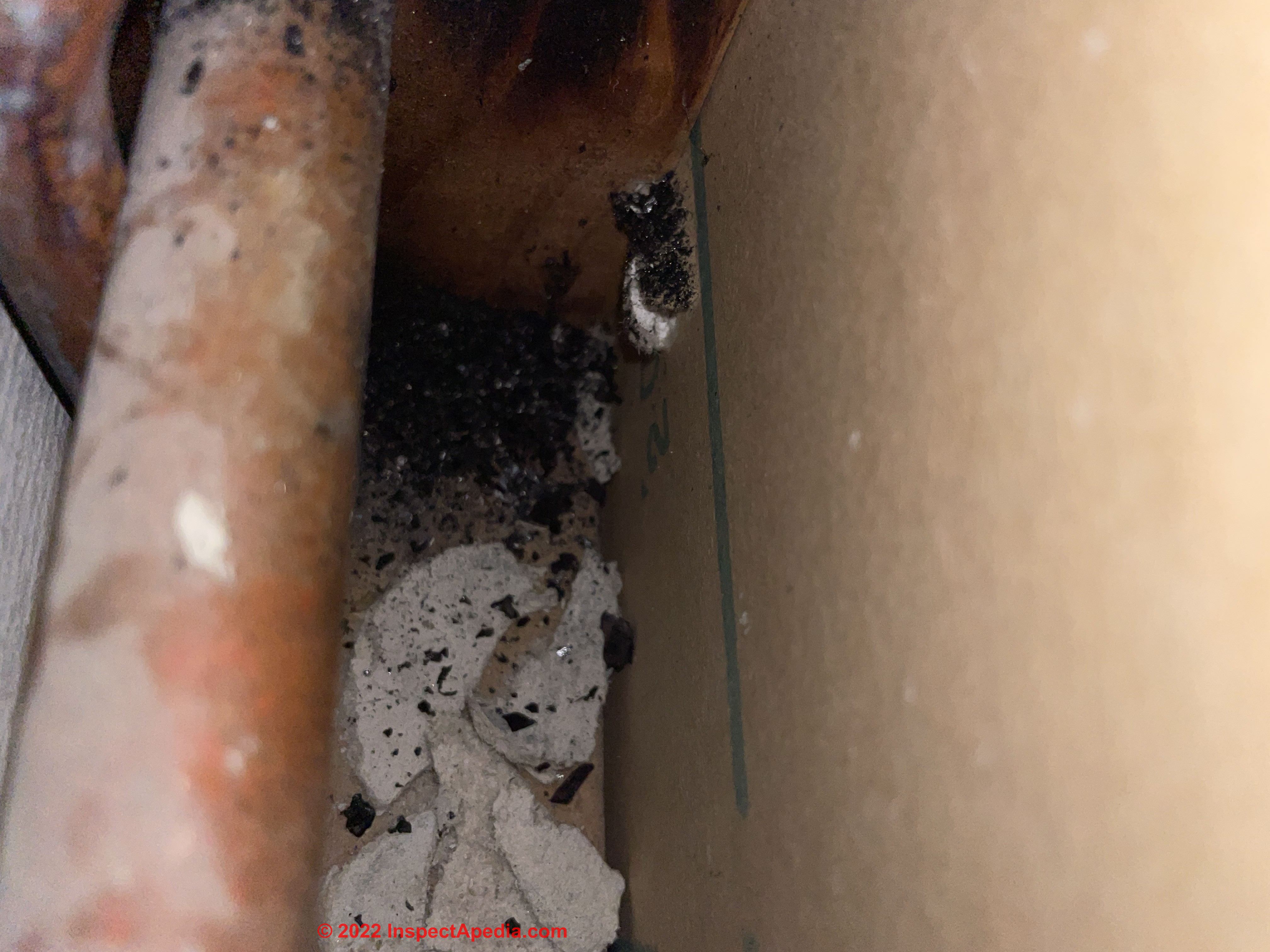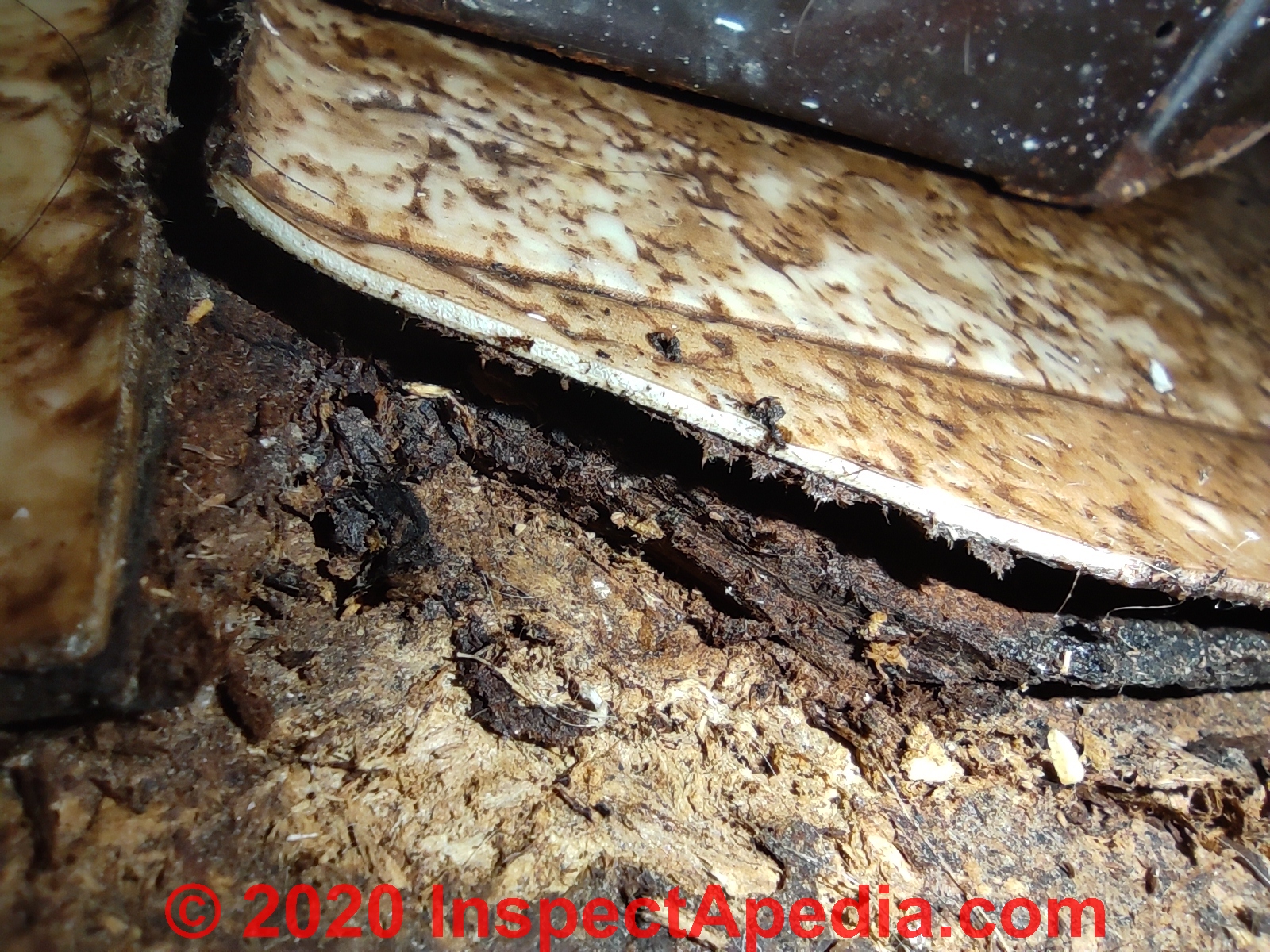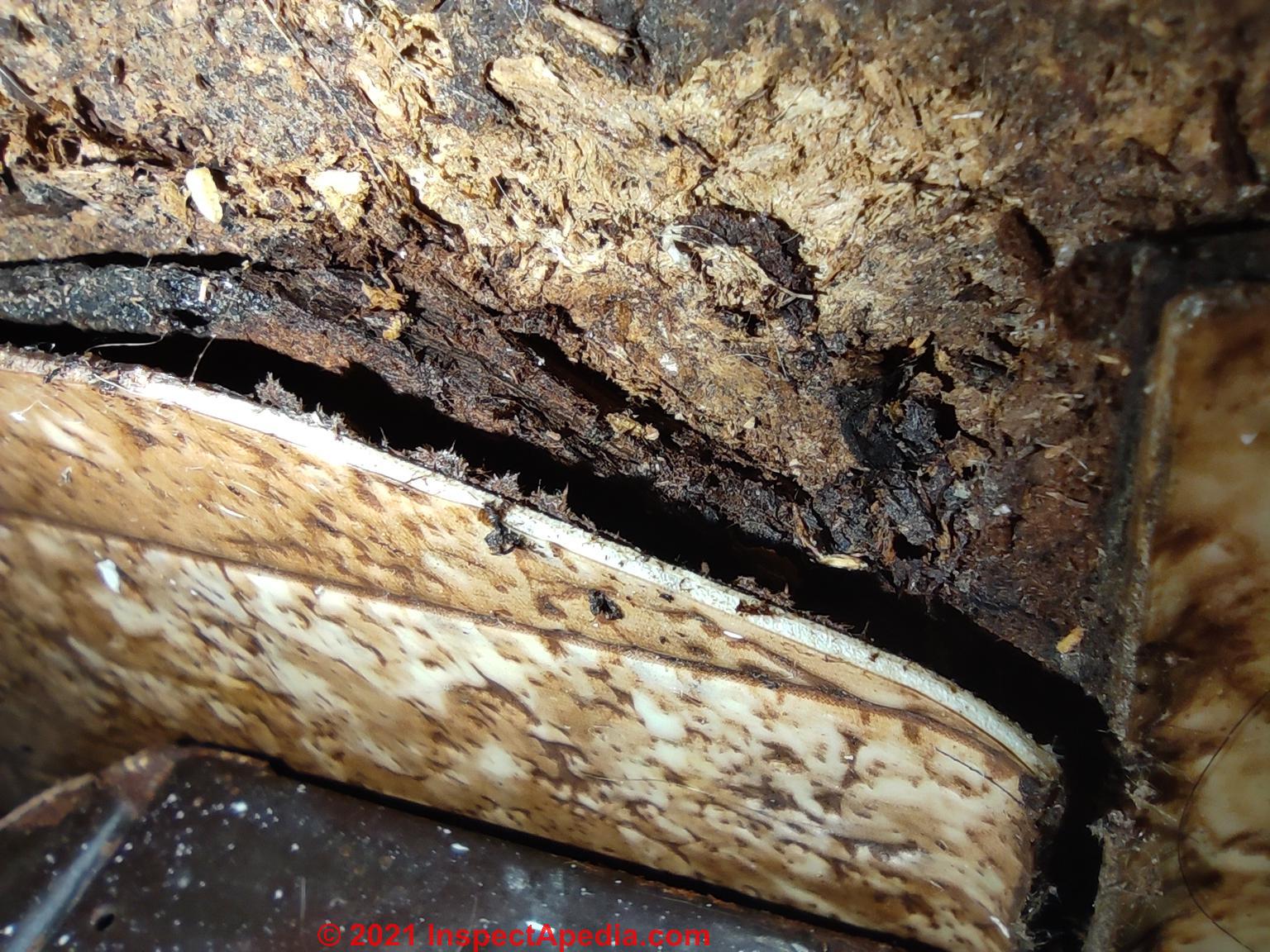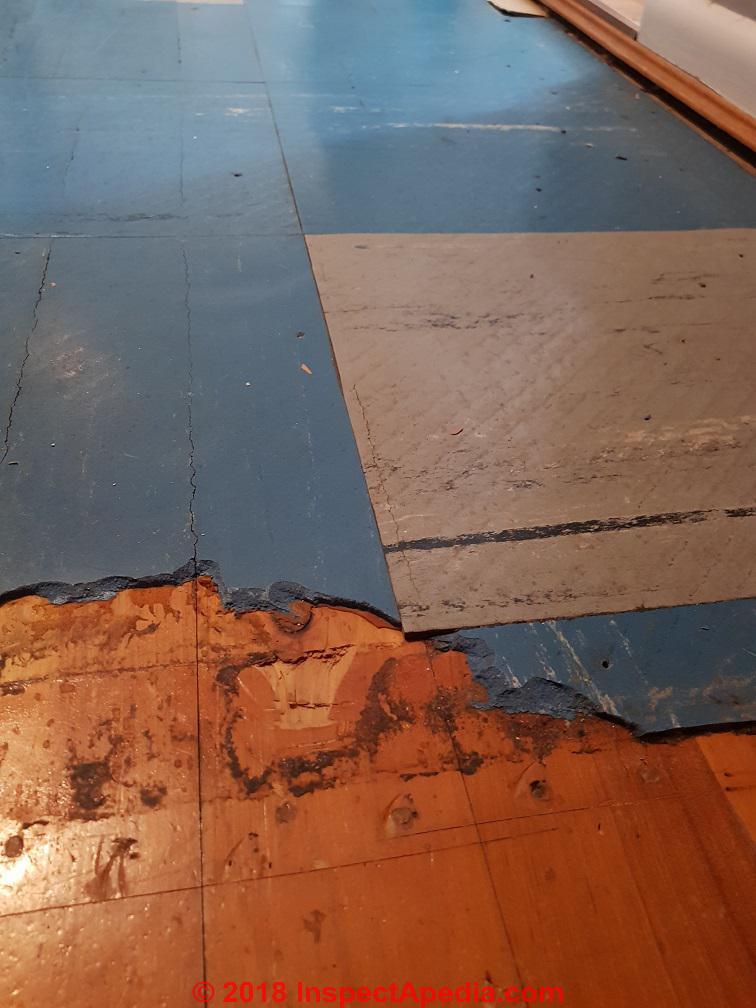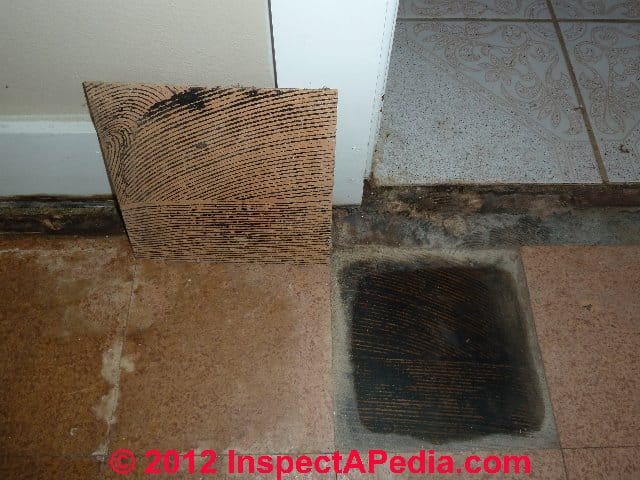 Asbestos Products in Australia
Asbestos Products in Australia
History, uses, government guidelines, testing of asbestos in Australia
- POST a QUESTION or COMMENT about identifying Australian asbestos-containing materials
Asbestos was widely used in various products in Australia up to the mid 1980s and in some cases even into the early 1990s.
This article series provides a guide to identifying various asbestos-containing products including asphalt-asbestos, vinyl asbestos floor tiles, linoleum, and sheet flooring (resilient flooring), roofing, siding, insulation, etc.
InspectAPedia tolerates no conflicts of interest. We have no relationship with advertisers, products, or services discussed at this website.
- Daniel Friedman, Publisher/Editor/Author - See WHO ARE WE?
Asbestos in Some Australian Products
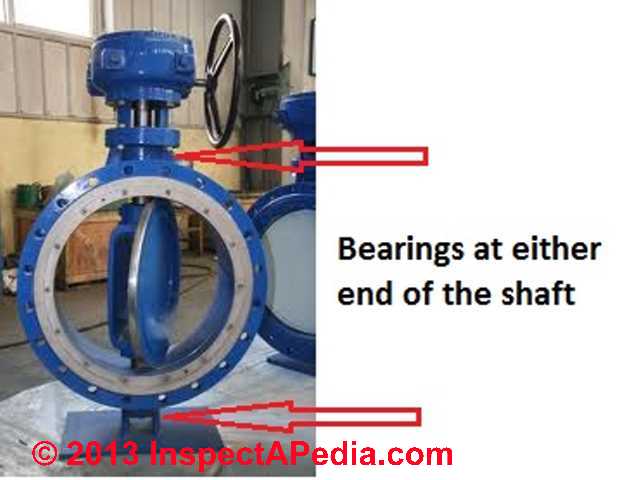 Asbestos is safe and legal to remain in homes or public buildings as long as the asbestos materials are in good condition and the asbestos can not be released into the air.
Asbestos is safe and legal to remain in homes or public buildings as long as the asbestos materials are in good condition and the asbestos can not be released into the air.
Australian Regulation of Asbestos Containing Products
According to the Government of South Australia Safe Work SA,
- The use of all types of asbestos in the amphibole group was banned in the mid 1980s.
- Chrysotile asbestos was banned on 31 December 2003
According to Australian contractor Bill Bradley, referring to Fibaro asbestos-cement roofing,
"Only cement sheet products made before 1987 contain the deadly stuff.
In NSW, for example, the use of it was discontinued in cement sheets by 1982, in corrugated sheets by 1984 and in all other products by 1986.
Products containing asbestos have been totally banned in Australia since 2004."
Congoleum Sheet Flooring Backer Text - Australia 1970's - Asbestos?
 This Congoleum sheet flooring and the photographs of text on the flooring backer were observed in an Australian home.
This Congoleum sheet flooring and the photographs of text on the flooring backer were observed in an Australian home.
The design pattern looks like some older sheet flooring whose backer contained asbestos. But we're not sure where nor just when this particular floor covering was produced.
Asbestos was found in at some Congoleum flooring products including:
Congoleum-Nairn Flor-Ever Vinyl, Fashionflor Cushioned Vinyl flooring, Gold Seal Vinyl Inlaid flooring, Gold Seal Vinyl Nairon Standard flooring.
The pattern shown above does not appear in the current (2016) Congoleum sheet flooring catalogs scanned online at the company's website.
However the reference to Seam Sealer SU 106 suggests that this might be a more-recent Congoleum flooring product. If so it would not be expected to contain asbestos. Thanks to readers L and G.R. 2016/03/31
Above: text indicating that seams of this flooring product should be sealed with Congoleum SU106 seam sealer.
Congoleum's SU106 seam sealer is a current product (2016). This product is applied on top of the seam of Congoleum sheet flooring that has already been joined below using QuikStik adhesive tape.
(You'll need to protect the sealed Congoleum floor seam from foot traffic for at least 16 hours.)
This same seam sealing product can be used to repair small areas of damaged or torn flooring.
Below: close-up photo of text on the "back" of Congoleum sheet flooring.
Modern, contemporary Airstep Congoleum sheet flooring seams are sealed with a Congoleum seam sealer kit and are used with Congoleum and IVC Flexitec vinyl floor coverings.
The company provides an adhesive sealer for sheet flooring and a "QuikStik tape used for loose-laid flooring seams and to adhere the perimeter of sheet flooring to the subfloor.
Sheet flooring can also be stapled down to wood floors or subflooring around its perimeter if those edges are to be covered by a wood floor trim.
Question: 1979 Congoleum The No Wax Shiny Vinyl - 20% Chrysotile Asbestos
I appreciate your website and have spent an extensive amount of time researching a flooring that we're removing from our house.
We got halfway through the floor removal before we realized we should worry about asbestos (yikes!).
I've ordered an in-home test kit but in the meantime I wondered if you had any thoughts on the attached photos?
Our home was built in 1979. The kitchen and dining room was covered in 12-foot wide vinyl sheet flooring made by congoleum.
On the backer, which is white, the Congoleum name appears, along with what appears to say "The No Wax Shiny [vinyl?]" There's something written above congoleum but I cannot make it out.
I appreciate any help or direction you can give us.
Also, I thought it would be helpful to future viewers of your website to see another sample. - Anonymous by private email 2018/12/03
Reply:
With no other more precise date information you need to either treat the floor as presumed to contain asbestos or have a sample tested.
If you can remove the floor without making a dusty mess you might eschew testing.
Reader follow-up: 20% chrysotile asbestos in this Congoleum No-Wax vinyl flooring
Just an fyi...this flooring came back 20% chrysotile asbestos in the flooring itself, none in the mastic glue.
Reply: thank you
Thank you Anon. Other readers will benefit from your report confirming asbestos in this 1979 Congoleum No-Wax Shiny Vinyl sheet flooring.
In my experience often the white backer of sheet flooring from the 1970's contained Chrysotile asbestos.
If the flooring adhesive can be dissolved - sometimes by mere water - enough that the flooring can be rolled-up and removed, you will have avoided creating potentially-hazardous asbestos-contaminated dust.
Armstrong Corlon vinyl flooring (containing asbestos) was sold world wide; some of these ads appeared in the U.K., Australia, and other countries.
Above: Armstrong resilient flooring: Left: Montina Vinyl Corlon and Right: 1959 Armstrong Vinyl Corlon advertisement
Reader Question: Is it likely that this bath ceramic tile black mastic in my 1986 home in Australia would contain asbestos?
I posted a question in the Comments section regarding my bathroom Reno.
[Click to enlarge any image]
Shown here: reader's photos of ceramic bath tile and black tile mastic in a 1985-1986 Australian home.
My house is from 1985/86, the cement sheeting in the shower areas say “Manufactured With Asbestos”.
Before I remove the wall tile, I would like to know if there is any chance the adhesive could contain asbestos. I am sending images as requested.
Any information appreciated.
Although I can see some kind of fibre in the images, I have read that they can’t be seen without a microscope. Seems to be a lot of confusing info out there. - Anonymous by private email 2017/08/24
Reply: Australian & possibly some U.S. manufacturers stamped cement board as not made with asbestos in the late 1980's
In both the U.S. and Australia it would be unusual for new construction in 1985/6 to have used asbestos products.
At the time of my initial reply I had not yet seen your photos of the mastic used behind ceramic bath tile, nor your backer board photo, so I offered this general advice:
 I'm not sure if you saw my note or if I was clear before about the possibility of asbestos in tile mastic.
I'm not sure if you saw my note or if I was clear before about the possibility of asbestos in tile mastic.
See ASBESTOS-CONTAINING ADHESIVES - for floor tiles
and ASBESTOS MASTIC IDENTIFICATION - Tile Mastic or Roofing Sealant Adhesive that may contain asbestos: Identification
and ASBESTOS-CONTAINING MASTIC DANGEROUS? - Demolition or remodeling advice for old tile floors or for roofing flashings, sealants & mastics
From the fact that you saw asbestos-suspect wall materials it certainly believable that a contractor would have used a mastic that contained asbestos. However that's not a friable material unless you grind or saw to make a Dusty mess.
I would much like to see a photo of the printing on the cement board or asbestos board that you found.
Also if you tell me what your plans are for the wall I might be able to make a suggestion. That is are you just stripping tile or do you need to take the whole wall down.
Reader follow-up
Here is a picture of the cement sheet, (shown above) this on several of the sheets in the other bathroom in the house.
I was planning on just removing the tile, but if I have to, I can certainly remove the whole sheets containing the tile.
... Oh ...,
I just noticed on my first email that I put “Manufactured with Asbestos” it SHOULD HAVE READ “Manufactured WITHOUT Asbestos”
Reply: Australian cement board installed 1985-1986, manufactured without asbestos
Aha so we found that the wallboard was marked as NOT containing asbestos. An easy misread to make when we're nervous about asbestos in a home.
The no-asbestos stamp on the cement board in your home reminds us that at the time your house was built, manufacturers as well as installers of fiber cement tile-backer board and other cement board products faced customers who wanted to be sure they were not being sold old-stock of asbestos containing products.
One could speculate that the same contractor who installed such cement board would not have intended to use a mastic tile adhesive that contained asbestos.
OPINION: Adding that to the generally not friable nature of tile mastics the risk of asbestos from the wall demolition is likely to be low.
Only if you were facing an unavoidable requirement to grind, chop, saw or otherwise make a dusty mess might you add asbestos to the general concern that you ought to have anyway about avoiding breathing demolition dust.
Also see this fiber cement tile backer board discussed
at NON-ASBESTOS FIBER CEMENT BACKERBOARD examples found in CEMENT BACKERBOARD INSTALLATION - Editor
Asbestos in Australian Building Insulation
 Though the practice was not common world wide, asbestos was used directly as a building wall or ceiling insulation material as installed by Mr. Fluffy in Canberra, as we discuss below.
Though the practice was not common world wide, asbestos was used directly as a building wall or ceiling insulation material as installed by Mr. Fluffy in Canberra, as we discuss below.
- Armstrong, Bruce,
"HOW DANGEROUS IS IT TO LIVE IN A MR FLUFFY HOUSE?" [PDF] The University of Sydney
Senior Adviser, The Sax Institute, Sydney, retrieved 2018/03/11, original source:
https://rsph.anu.edu.au/files/Mr%20Fluffy%20150804.pdf
Except:
"Mr. Fluffy: From 1968 to 1979, D Jansen & Co Pty Ltd. (Mr Fluffy) insulated ~1,100 residences in Canberra by blowing loose-fill asbestos into their ceiling spaces; amosite in most cases, crocidolite in a few." - Lew, Dan, "Mr Fluffy – Asbestos Marketing and the (Mr. Fluffy) asbestos crisis in Australia", HazMat Environmental, 2017/10/24, retrieved 2018/03/11, original source: http://www.haz-mat.ca/2017/10/24/mr-fluffy-asbestos-marketing-mr-fluffy-asbestos-crisis-australia/ , Excerpt:
“Retains Effectiveness Forever” - Mr Fluffy refers to a widespread asbestos contamination incident that occurred in the suburbs of Canberra, the capital city of Australia.
Two companies, referred to collectively as Mr Fluffy (a nickname coined in the 1990s for Asbestosfluf Insulations, and its successor J&H Insulation, the former run by Canberra businessman Dirk Jansen, the latter owned by a relative of his), imported and installed fibrous, loose-fill amphibole asbestos (in most cases brown amosite, though instances of blue crocidolite have been recorded) as an insulation by blowing the product into roof spaces of homes during the 1960s and 1970s.
Additionally, the companies are believed to have sold sacks of asbestos fibre direct to homeowners to insulate their own homes, and other operators may have also used the hazardous material trying to copy Jansen’s business model. - in turn excerpted or adapted from Wikipedia, https://en.wikipedia.org/wiki/Mr_Fluffy as of 2018/03/11
An Australian government survey reveals a quarter of homeowners affected by the ongoing Mr. Fluffy asbestos crisis in Canberra have mental health issues, some as serious as suicide, according to the Canberra Times.
Australian readers concerned about Mr. Fluffy insulation should also see the
- Australian National Asbestos Register at https://www.asbestossafety.gov.au/national-asbestos-exposure-register
The agency strongly encourages you to use the online registration form, but if you cannot do this, please email enquiries@asbestossafety.gov.au to request a PDF form which you can fill out on your computer.
Asbestos in Australian Toasters & Toaster Covers
Asbestos was widely used in toasters in several forms including electrical wire insulation, toaster side insulation, and heating element carriers from about 1910 through the 1970's and in some toaster appliances even into the mid 1980's.
Asbestos was also used in toaster covers (Landry 1981).
Butler (1903) patented a hand-held bread toaster (not-electric) that used or might use asbestos as one of the early U.S. patents citing use of asbestos in toasters.
Asbestos was still being used in toaster appliances in 1982 (Zim 1982) and is described in baking and frying appliances in 1984 (Matz 1984).
- Anderson, Roy J. "Electric toaster." U.S. Patent 2,548,511, issued April 10, 1951.
See details at ASBESTOS USE in APPLIANCES
Asbestos Electrical Friction Materials in Australia
Asbestos is an important and major constituent of many types of friction materials. Modern industry makes use of friction materials in a wide variety of applications—automobiles, trucks, hoists, washing machines, and other moving or rotating equipment. See Figures 7.1 and 7.2 below.
Photos above: chrysotile asbestos was found in this 78” butterfly valve installed in a power station in Melbourne, Australia - discussed in more detail under Bearing Compnents
at ASBESTOS PHOTO GUIDE to MATERIALS.
Research on Asbestos Uses & Products in Australia
- 1981-1991: Australia introduced a ban on all ACM in 1991 (in-stock materials continued to be sold) [28]
- Accoflex 2005 series semi-flexible vinyl tile flooring product description; Armstrong's Accoflex is a vinyl composition floor tile. WonderFlooring, Private Bag X02, Fordsburg 2033, Telephone: 011 298 8100, Fax: 011 836 4450, National Call Centere: 0860-29-80-80, Email: info@wonderflooring.com
Web search 01/29/2011, original source: http://www.wonderflooring.com/accoflex/accoflextech2.pdf Reference: Armstrong Flooring: Accotile, Accoflex & Coke Tile. Publication 333, Armstrong Flooring.
Note on use of the "Accoflex" name:
In addition to Accoflex flooring produced by Armstrong, Accoflex® is also a U.S. registered trademark used for Insulation Jackets For Industrial Pipes, Tanks and Conduits Including Flexible and Rigid Insulation In the Form of Foamed Synthetic Material Sheeting, owned by Armacell Enterprise Gmbh, Armstrong World Industries, Inc, also distributed in the U.K., Australia, & New Zealand, also in Indonesia.
Armacell Australia Pty Ltd, a producer of engineered foams, (http://www.armacell.com/) was founded officially in August 2000 when the then Armstrong Insulation Products (Australia) became a separate legal entity from Armstrong World Industries group. - ASBESTOS, WHAT YOU SHOULD KNOW, Government of South Australia, web search 10.05.2010, original source: http://www.safework.sa.gov.au/uploaded_files/asbestos_whatyoushouldknow.pdf
SafeWork SA Mineral Fibres Unit, Telephone: (08) 8303 0405
Dr Joe Crea, Chief Advisor - Hazardous Substances, SafeWork SA, Telephone: (08) 8303 0207, E-mail: crea.joe@saugov.sa.gov.au
Asbestos Victims Association (SA) INC, Telephone: (08) 8331 0254
Australian Environmental Protection Authority (EPA), Telephone: (08) 8204 2004 - ASBESTOS, A GUIDE for MINOR RENOVATION, [PDF] Australia DEIR, includes common locations where asbestos is found in Queensland homes,
retrieved 2018/04/05, original source: http://www.deir.qld.gov.au/asbestos/resources/pdfs/asbestos-home-renovators-trades-guide.pdf
Excerpt:
This guide, produced by the Queensland Government, is based on an original guide entitled Asbestos: A home renovator’s and tradesperson’s guide for minor work in domestic buildings. - ASBESTOS PRODUCTION QUANTITY - includes tables of production quantities of asbestos in Australia
- Australia: SEALING, PAINTING, COATING & CLEANING of ASBESTOS CEMENT PRODUCTS [PDF], Victoria Government, Australia, retrieved 2019/08/28 original source: http://www.asbestos.vic.gov.au/in-the-workplace/sealing-painting-coating-and-cleaning-asbestos-cement-products
- Australia: SAFE PRACTICES for HOMEOWNERS REPAIRING or REMOVING SMALL AMOUNTS of ASBESTOS MATERIALS [PDF] ADRI, Asbestos Diseases Research Institute, Asbstosawareness.com.au and the Australia Asbestos Education Committee - retrieved 2019/08/28 original source: asbestosawareness.com.au/wp-content/uploads/2016/11/Fact-Sheet-2-Detailed-Asbestos-Management-1.pdf
- Australia: SAFE CUTTING HANDLING REMOVAL of TRANSITE PIPE [PDF] retrieved 2019/08/28 original source: https://www.qldwater.com.au/_literature_232979/Asbestos_Cement_Pipe_Cutting_Guidelines_June_2014
- Australia: ASBESTOS GUIDE for MINOR RENOVATION [PDF] Queensland Government, Australia, retrieved 2019/08/28 original source: https://www.bundaberg.qld.gov.au/files/document19919.pdf
- Asbestos Test Laboratories in Australia
In Australia the National Association of Testing Authorities, Australia, maintains lists of accredited service providers. Search the NATA website given below for "Asbestos Testing"
see ASBESTOS TEST LABS in AUSTRALIA at NATA - http://www.nata.com.au/nata/ - Barton, Ruth. "Household technology in Western Australia 1900-1950." Oral History Association of Australia Journal, The 7 (1985): 108.
Excerpt:
In East Fremantle, about 1910, they heated their iron on a flat piece of asbestos laid over the top of a primus stove rather than on ... - Cementious siding materials such as JAMES HARDIEPLANK® FC SIDING (also see Hardie's Fibrolite™ or Fibro where used in Australia) and cementious roofing materials such
as ASBESTOS & FIBER CEMENT ROOFING - Donlevy, Neil & Jefferson Gibbs, KPMG, "VALUATION of Asbestos-Related Disease Liabilities of former James Hardie entities (“the Liable Entities”) to be met by the AICF Trust" [PDF], (2016)
Executive Summary Excerpt:
This valuation report (“the Report”) has been prepared by KPMG Actuarial Pty Ltd (ABN 91 144 686 046) (“KPMG Actuarial”) in accordance with an “Amended and Restated Final Funding Agreement in respect of the provision of long-term funding for compensation arrangements for certain victims of Asbestos-related diseases in Australia” (hereafter referred to as the “the Amended Final Funding Agreement”) between James Hardie Industries NV (now known as James Hardie Industries plc) (hereafter referred to as “James Hardie”), James Hardie 117 Pty Limited, the State of New South Wales and Asbestos Injuries Compensation Fund Limited (“AICFL”) which was signed on 21 November 2006.
This Report is intended to meet the requirements of the Amended Final Funding Agreement and values the asbestos-related disease liabilities of the Liable Entities to be met by the AICF Trust.
This Report is not intended to be used for any other purpose and may not be suitable, and should not be used, for any other purpose. Opinions and estimates contained in the Report constitute our judgment as of the date of the Report.. - Higgins, Caire, ASBESTOS DISEASES
COMPENSATION BILL 2008 [PDF] Parliament of Victoria, Research Service,
Parliamentary Library,
Department of Parliamentary Services, D-Brief No. 5, 2008
An examination of the Asbestos Diseases Compensation Bill 2008, the history of asbestos use in Australia, and law in other jurisdictions.
NB: Readers should note that this paper was prepared prior to the passage of the Asbestos Diseases Compensation Bill 2008 through the Victorian Parliament. It was passed by the Legislative Council on 13 November 2008. Readers interested in this Act as passed should visit the Victorian Legislation and Parliamentary Documents website @ http://ww.dms.dpc.vic.gov.au.
Excerpt:
Asbestos is a broad term encompassing several fibrous mineral deposits. Of these, chrysolite (white asbestos), crocidolite (blue asbestos) and amosite (brown asbestos) were mined or used in Australia.
Prized for its lightweight, heat resistant qualities, asbestos was used in Australia from about 1900 to 1987 in commercial manufacturing and construction, as well as in domestic environments. Consumption of asbestos products peaked in Australia around 1970, and it has been argued that Australia had one of the highest consumption rates per-capita in the world.
Much of the asbestos fibre used in Australia during this period was imported from South Africa and Canada.19
A small number of asbestos mines operated in Australia. Blue asbestos, the most deadly form, was mined at Wittenoom in the Pilbara region of Western Australia. Established by Lang Hancock in 1938, the mine was taken over by a subsidiary of the Colonial Sugar Refining Company (CSR) in the 1940s, and closed in 1966.
Other mines included Baryulgil and Woodsreef in New South Wales, which both produced white asbestos for James Hardie Industries and operated until 1976 and 1983 respectively.
James Hardie was the largest producer of asbestos products in Australia. - Hills, B. (1989) Blue Murder: Two Thousand Doomed to Die – The Shocking Truth
About Wittenoom’s Deadly Dust, South Melbourne, Sun Books.
… in the mill it [level of airborne asbestos dust] was blinding. One hundred-watt light bulbs hanging from the ceiling of the tin shed looked like candles, one worker recalls. When you walked in, you had to get within a couple of feet of a man to recognise him, because their faces were coated with dust like pancake make-up.
- Johnson, Nathan, "Made in China (with asbestos): MBA raises alarms" [news article], 2015/02/26 - retrieved 2017/03/24, original source: http://www.architectureanddesign.com.au/news/made-in-china-with-asbestos-mba-raises-alarms
Excerpt:
Master Builders Australia (MBA) have released an alarming media release warning the Australian design and construction industry to be wary of imported Chinese building products “laced with asbestos”.
MBA reported that Australian border-security officials have admitted to a limited capacity to stop contaminated goods entering Australia and that the Abbott government has conceded it is unable to guarantee Chinese imports are free of asbestos, amid some evidence of its use in the car, mining and building industries. - Musk, Arthur W., Nola J. Olsen, Alison Reid, Tim Threlfall, and Nicholas H. Klerk. "Asbestos‐related disease from recycled hessian superphosphate bags in rural Western Australia." Australian and New Zealand journal of public health 30, no. 4 (2006): 312-313.
...
Reader Comments, Questions & Answers About The Article Above
Below you will find questions and answers previously posted on this page at its page bottom reader comment box.
Reader Q&A - also see RECOMMENDED ARTICLES & FAQs
On 2022-06-28 by Alex - is this white material in my building walls asbestos
Asbestos suspect white material in Australia Photo 3 [above]
Asbestos suspect material in Australia, photo 2 [below]
I am emailinginstead of via the comment box because it appears I can only upload one picture - I believe that multiple pictures may help.
For context, in the bathroom vanity cupboard (under the sink), there appears to be a small cut out hole exposing the water pipes. This small appears rather small which leads me to believe it was cut out for inspection of a possible pipe leak that would have occurred with the previous owner.
I conclude this as it looks like soldering was performed on the pipe. The hole is small enough to fit my iPhone through it to get some photos.
Where the hole is cut, there is a wall stud which the pipes appear to go through. Facing downwards to the ground, I noticed these on the ground - looks fibrous so not sure whether this is asbestos or not?
It's a bit interesting if it is and that when the pipe was repaired, it was left there. I am hoping that it is nothing more than someone trying to mitigate the supposed water pipe leak with spray foam.
The house is a unit in Australia built in the 80s when asbestos material was being phased out..
I appreciate any advice you may have and I hope the pictures are enough for you to analyse.
On 2022-06-28 by InspectApedia-911 (mod) - possible asbestos paper heat shield used to protect flammable building components during soldering or brazing
@Alex,
I agree that those white material scraps could be an asbestos product possibly remnants of insulation that was put in place to avoid a fire during brazing or soldering.In your first photo of white fragments in a wall cavity I couldn't see enough to distinguish between asbestos paper and fragments of Australian gypsum board or drywall.
But in some of your subsequent photos the curved, layered papery fragments indeed resemble asbestos paper pipe or duct wrap that might have been used during plumbing work.
In your photo shown here we see charring and black marks on building materials (possibly a wood framing member) inside of a tan fibreboard covered wall, an area where indeed a plumber might have used thick asbestos paper or boards to avoid starting a building fire.
Indeed when I did plumbing and heating work in the U.S. in the 1970s I bought such materials from my plumbing supplier, and use them myself, placing the asbestos between the pipe I was to solder or sometimes braze (in refrigeration piping) and nearby building materials.
Therefore, from the appearance, location, and context of possible use, asbestos is a plausible guess for the fragments in some of your photos.
But you really can't know for certain from those photos if a white paper material is - for fact - asbestos: you'd have to have a sample tested.
Frankly there's no reasonable chance that there's an asbestos hazard in the building from those scraps left un-disturbed inside of a wall cavity unless the cavity were being used as part of a heating or cooling air duct system or something similar.
Incidentally you can always post multiple pictures at inspectApedia simply by posting multiple comments. I'm sorry for the inconvenience but that's the design of the software - I've asked the developer to consider the multi picture option.The light yellow-tan fiberboard itself is more-likely a wood fiberboard product. Not itself asbestos.
HISTORY of MASONITE HARDBOARD in AUSTRALIA
is of interest
On 2022-01-12 by Anonymous does modern vermiculite fireproofing spray on in Australia contains asbestos?
Anonymous asked:
This is a query regarding a possible new purchase.
Very good site. I just wish to know if modern vermiculite fireproofing spray on in Australia contains any asbestos (or is it legislated out ) and Is it okay to sand this modern vermiculite fireproofing spray on ?
On 2022-01-12 by Inspectapedia Com Moderator (mod) -
@Anon:
Please note this excerpt from the page above:
Australian Regulation of Asbestos Containing Products
The use of all types of asbestos in the amphibole group was banned in Australia in the mid 1980s.
Chrysotile asbestos was banned in Australia on 31 December 2003
From this you should be assured that no building product or spray or ceiling paint coating sold in Australia after those dates would be an asbestos hazard.
Watch out: that does not mean that sanding byproducts or dust from building renovations or demolition are harmless. Proper dust control, personal protective equipment, and cleanup are always in order.Hazards other than asbestos can be found in dust from sanding or scraping building surfaces, even modern ones, such as silica dust, plaster dust, sometimes less-than-obvious mold or other hazardous materials, and in older buildings other hazards such as lead paint.
On 2020-09-29 by Sheet flooring ID - incredible amount of info on this page! Hoping to get a little advice too.
What an incredible amount of info on this page! Hoping to get a little advice too..
Our house was built in the mid 1980s in Australia. Any ideas about this sheet flooring material that came in 201cm / 6.7' / 79" width?
It looks like it is installed on a masonite backing laid on top of chipboard/yellow tongue subfloor sheets.
I could only attach one image, but perhaps some others help... please excuse the filth!
This patch of floor is where someone previously pulled up the flooring and masonite (?) backing probably after removing a cabinet in the corner.
Being next to the oven it's gotten very dirty and oily. The cut I've made in the vinyl/lino is fresh.
Thank you so much for your insight!
This Q&A were posted originally
at ASBESTOS FLOORING IDENTIFICATION GUIDE INDEX - all brands, all years
On 2020-09-29 by (mod) - treat 1980's sheet flooring in Australia as presumed to contain asbestos - or have it tested
Sheet:
I looked at your other photos and will post one of them below;
The subfloor is certainly a wood product; it's so water damaged I can't tell if it's OSB or a hardboard product. But those materials are consistent with a mid 1980's home in much of Australia.
Where would asbestos be if it's in your flooring? Asbestos in Australian flooring was used in the white backing of some sheet flooring and in the body matrix of some - many - floor tiles.
Here is what the Australian government's Department of Health tells us - and it's about all we've got unless you decide to have your Aussie flooring tested for asbestos:
As a General Rule ... if your house was built:
before the mid-1980s it is highly likely that it has asbestos-containing products
between the mid-1980s and 1990 it is likely that it has asbestos containing products
after 1990 it is unlikely that it has asbestos-containing products.
Some houses built in the 1990s and early 2000s may have still used asbestos cement materials until the total ban on any activity involving asbestos products became effective from December 2003.
- source: Australian Government Department of Health, When and Where was Asbestos Used, A Guide for Homeowners and the General Public, (2022) Original source (defunct in 2024) was https://www1.health.gov.au/internet/publications/publishing.nsf/Content/asbestos-toc~asbestos-when-and-where - local copy saved as Asbestos-A-guide-for-householders-AU.pdf
So to err on the safe side, while indeed that sheet flooring could be free of asbestos, until you have a sample of that flooring tested, treat the floor as presumed to contain asbestos.On 2020-10-09 by Anonymous - this flooring was tested: came back negative for Asbestos
THANK YOU so much for your insight. By your comment "Where would asbestos be if it's in your flooring? Asbestos in Australian flooring was used in the white backing of some sheet flooring and in the body matrix of some - many - floor tiles", I agreed..
there doesn't seem to be any white backing.
The white in the product is in the vinyl itself.
And it didn't look fibrous to me at all.
But on your advice in the last line of your comment and from a concerned flooring company, I had it tested. It came back negative for asbestos.
Yey! I hope the pictures might help someone else identify their flooring as well.
Thank you again for a very informative and helpful site! Keep up the good work.
Comment: Possible asbestos in fibreboard / sheeting, at old pub 1888 in the Riversdale Hotel
 I've attached some photos [that caught my attention] for the InspectApedia archives.
I've attached some photos [that caught my attention] for the InspectApedia archives.
This is regarding an old Pub here in Melbourne [Australia] and it was built in 1888 by Annie Rosey.
This is the Riversdale Hotel, - Source: Riversdale Hotel, 277 Auburn Road - Hawthorn East 3123, Melbourne Australia Tel: (03) 9882 3361 retrieved 2020/01/19 original source: https://www.riversdalehotel.com.au/our-story
The photos I have taken are in the Utility room [toilets] where I noticed this exposed substrate board, with some writing on it,
Do Not Breathe Dust Wear Respirator
Please find attached photos.
The Riversdale Hotel, 277 Auburn Road, Hawthorn, designed by architect William Pitt and constructed in 1888 for owner John J Rosney.
The hotel was run by JJ Rosney until his death in the early 1890s, after which his
widow, Annie Rosney, was the owner and licensee until 1930.
- Source: RIVERSDALE HOTEL [PDF] Victorian Heritage Database, GPO Box 527, Melbourne VIC 3001 Australia, Email: heritage.council@delwp.vic.gov.au Tel: (03) 9194 0868. Report 2020 - retrieved 2020/01/19 original source:
https://vhd.heritagecouncil.vic.gov.au/places/199603/download-report
I thought it was something that you don't see very often these days as most places are renovated and/ or covered up. - Marc Joshmar - Melbourne
Reply:
I agree that the warning imprinted on this material is not often seen.
Zooming in on your photo to see the edges of the material and the mounting screws suggest that this is either a type of fibreboard or an asbestos-cement board, though without a closer look, sorry to say I can't even rule out gypsum board or Gyproc.
Go back to the pub and have a beer for me, and if you can do so without being accused of being crazy, see if you can get a sharper photo of the edges of the material.
On 2019-01-12 by Christopher
Hi,
Recently removed floating floor boards to get carpet installed and under the dining room area found tiles as shown in the attached images.
The house was built in Western Sydney of Australia around the 1970's from what I can tell, not sure when these tiles were placed.
Do these [floor tiles shown above] look to be asbestos containing?
On 2019-01-12 by (mod) - asbestos-containing 1970's floor tiles in Western Sydney Australi
Yes Christopher.
Photo: two layers of floor tiles, at least the earlier layer of which may contain asbestos, from the 1970's in Sydney Australia.
On 2018-03-11 by Alyssa - Did the old 1927 GE monitor top refrigerator have asbestos?
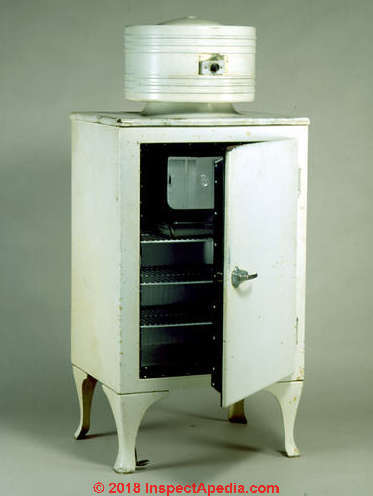 Did the old 1927 GE monitor top refrigerator have asbestos?
Did the old 1927 GE monitor top refrigerator have asbestos?
On 2018-03-11 by (mod) - use of asbestos in GE Monitor-top type refrigerators in Australia
Here is an image of the GE Monitor-Top type refrigerator from 1927, from the Victoria Australia museum collection. [Click to enlarge any image]
Alyssa
Possibly, but my research did not find any mention of asbestos in the description of the GE monitor-top refrigerators.
The GE Monitor Top refrigerator was a major product development for General Electric and was widely sold and is still recognized world-wide.
I searched particularly for refrigerator insulation and for refrigerator gaskets and gasket patents associated with GE from 1925 - 1930 to see if those mentioned use of asbestos and did not find that indicator.
Givens, Albert L. "Refrigerator." U.S. Patent 1,533,646, issued April 14, 1925. Original Assignee General Electric Co
Sywert, Philip T. "Gasket." U.S. Patent 1,694,291, issued December 4, 1928. I will include an image from this patent)
Griffiths, Richard T. "Packing gasket and method of making same." U.S. Patent 1,705,455, issued March 12, 1929.
Asbestos could also have been used as a refrigerator body or door insulating material, though I did not find that either (yet - I'm still researching).
Other patents from the same era such as Carrey, 1930 do cite use of asbestos in the refrigerator construction.
- Carrey, John O. "Vacuous refrigerator and method of maintaining vacuum therein." U.S. Patent 1,747,969, issued February 18, 1930. Original Assignee C & C Engineering Company Inc
Excerpt from that patent:
A U-shaped strip 24 of heat non-conducting material such as asbestos is placed over the bent edge 20 and a thin sheet 25 of lead is then placed over the U-shaped strip 24 and the whole is then forced into the pocket 23, and the assembled joint has the lead covering 25 bearing against the inner face of rebent edge 21 and the edge from edge 21 by asbestos covering 24.
Also Ballew 1925 describes use of asbestos in the refrigerator doors:
- Ballew, Neual W. "Vacuum-insulated container." U.S. Patent 1,561,769, issued November 17, 1925.
The inner shells each contact with the outer shell only over a small surface at its front end. The doors 4:, where they contact with the outer shell may be lined with a suitable heat insulating material, such as cork or asbestos, not shown.
On 2018-03-21 by James - commercial vinyl floor tiles in Australia - streaky tiles
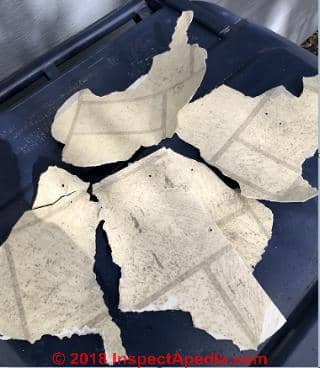 Hey, here in Australia we have the commercial vinyl tiles that that the streaks on them and even when there labelled with an asbestos register, every building the concrete cutters come through and cut through them to run drainage.
Hey, here in Australia we have the commercial vinyl tiles that that the streaks on them and even when there labelled with an asbestos register, every building the concrete cutters come through and cut through them to run drainage.
I've been sweeping up piles of broken tiles and dust. I ask the owner of the site and they just say it's ok because it's a quick cut saw with water. Am I at risk for mesothelioma?
Past 2 days I have worn a dust mask on site and everyone gives me love for it
On 2018-03-21 by (mod) - Australian Rules & Advice for Asbestos-Suspect floor tiles or sheet flooring
James
No one can assess your mesothelioma risk by an e-text. IF there was significant airborne dust that contained significant levels of asbestos that would be potential health hazard.Watch out: Sweeping up piles of broken tiles and dust certainly sounds as if the dust is not being controlled, notwithstanding that the cutting itself was done using water to keep dust levels down. Wearing an ordinary dust mask might reduce a dust hazard but it would not eliminate it.
In Australia workplace safety is regulated by WHS, Workplace Health and Safety) at https://www.australia.gov.au/information-and-services/jobs-and-workplace/whs-workplace-health-and-safety
This link https://www.business.gov.au/Info/Run/Workplace-health-and-safety
discusses workplace health and safety
This web page gives workplace health and safety laws
https://www.safeworkaustralia.gov.au/law-and-regulation/model-whs-laws
You can take working conditions (as well as pay) questions to the fair work ombudsman https://www.fairwork.gov.au/If you have a question or problem relating to your workplace, call the Fair Work Infoline on 13 13 94.
Before you call review the Australian Government's Fair Work Checklist at https://www.fairwork.gov.au/contact-us/call-us/before-you-call
On 2018-02-09 by Twogone - Congolium sheet flooring backer text - Australia 1970
Dear Sirs;
We have the exact flooring as shown above marked "Congolium sheet flooring backer text - Australia 1970?"
My wife and I purchased it at TILE TOWN in Vancouver some time in 1973 or 1974 and had it installed by "Willing Wayne the discounter" of Nanaimo some time in 1975.
After 43 years of use, children and abuse it is pretty beat up and my wife has asked me to replace it with luxury vinyl planks.
I believe there is too much indented pattern in the old floor to lay vinyl planks directly on top of it and leveling it presents more problems that removing it unless of course it has asbestos in the backing.
A couple of questions:
1 - How can I determine if there is indeed a significant amount of asbestos in this old flooring? and
2 - If the asbestos level is not extreme, is it safe for me to remove it carefully creating minimal dust? Thanks for your help,
On 2018-02-09 by (mod) - Congolium sheet flooring backer text - Australia 1970
Two
You'd need to send a flooring sample to a certified asbrestos test lab.
Or just leave it in place and install flooring over it. I'd think that planks wouldn't be bothered by dents in sheet flooring.
If you can remove the floor by rolling it up the asbestos hazard would be very low. If you tear, chop rip, sand, grind, that's another matter. If it's glued down that'd mean a lot more trouble to remove.
On 2018-02-09 by Twogone - Thank you ever so much for your most useful and detailed advice.
Thank you ever so much for your most useful and detailed advice. I have to tear up a small section under the dishwasher.
The old dishwasher leaked and caused the horrible old particle board to swell up and crumble. I had the same problem in both bathrooms where the toilets leaked and I replaced the particle board with 5/8 plywood.
Those projects went well and hopefully this one will too. By laying the planks on top of the old vinyl cushion floor I may have to remove a little trim under the lip of the counter because the new dishwasher is a very tight fit and the added thickness of the floor may cause it to jam. Unfotunately it does not have adjustable feet (legs).
The old vinyl IS glued down but not very well and hardly at all where the dishwasher sits. Thanks again for you help & Cheers; Twogone
On 2018-02-12 by (mod) -
Glad we could help.
On 2017-08-24 by Kim - asbestos in asphalt in tile mastic in Australia?
Hi, I am renovating the bathroom in our home, build in 1985 here in Australia. The Sheeting in the shower has the words Manufactured without asbestos.
I am removing the wall tiles and they have a black rubbery adhesive on them. Did these wall ahhesives contain asbestos at that time. Thanks.
On 2017-08-24 by (mod) -
Kim:
For sure, some black asphalt-based tile mastics or adhesives had asbestos.See MASTIC, CUTBACK ADHESIVE, FLASHING CEMENT ASBESTOS https://inspectapedia.com/hazmat/Floor_Tile_Mastic_Asbestos.php
You're welcome to send me photos using the page top or bottom CONTACT link and I may be able to comment further.
On 2017-06-22 by Mairi - asbestos insulating board has been removed - Thanks for this fantastic site.
Hi there,
Thanks for this fantastic site.
We moved into a 1979 Australian brick veneer house some years ago.
Loads of asbestos insulating board has been removed from the wet area since. In the kitchen, around the radiators and windows there remains a board which resembles the 10mm gyprock (gypsum board) but is thinner and sounds tinnier when tapped.
It seems to have a pink facing underneath the paintwork. I believe that it is fire retardant plasterboard which would have fibres added to the gypsum. I know that for a definitive answer testing is required, but wondered whether there was any wisdom on the usual additive during the 70s- I've read that glass fibre was the preferred additive by this time.
I've been okay with leaving it in situ but there is some prospect of disturbance now that we are replacing some radiators and the oven.
On 2017-03-24 by Rachelle - Renovating floors in a 1950's home in australia: risk of asbestos tile mastic
I have a 1950's home in Australia and we are renovating the floors.
We found that there are tiles under the current floors and we were hoping to go back to the wood floors underneath. The tiles are all loose and come up but I don't know how to get the glue off.
I am not sure if it contains asbestos or if the tiles were self adhesive. Appears that the glue is only directly under the tiles in the pantry area but we have not pulled up the whole kitchen yet
On 2017-03-24 by (mod) -
Rachelle:
To my surprise I found that some flooring adhesive is water soluble and ever since I try that first. Wetting also helps keeping dust down.
If you use the on-page search box find our article on ASBESTOS-CONTAINING MASTIC DANGEROUS? you'll see why we want to take care.
I'd try the most gentle solvents first (odorless paint thinner - ) if water doesn't do it.
In Australia Weber is a solvent supplier you'll find easily, or try a Taubman's Paint supplierFor other Aussie readers who are simply going to cover old asbestos-suspect floor tile adhesive
see FLOORING ADHESIVE MASTIC SEALANTS
Question: asbestos in sheet flooring in Queensland AU
(May 12, 2015) Tina said:
I have vinyl sheet in my kitchen unit built in 1986, seems to have a white backing and is stuck directly onto the concrete. Would this sheet have asbestos ? We are in Australia Qld.
Reply:
It's possible, of course. Please use our email found at the page top or bottom CONTACT link to send us some photos.
...
Continue reading at ASBESTOS FLOORING HAZARD REDUCTION - home, or select a topic from the closely-related articles below, or see the complete ARTICLE INDEX.
Or see this
Article Series on Congoleum Flooring
- ASBESTOS CEMENT PRODUCTS - home
- ASBESTOS ENCAPSULANTS & SEALERS
- ASBESTOS FLOORING HAZARD REDUCTION - home
- ASBESTOS FLOORING LEFT IN PLACE - coatings used atop vinyl-asphalt or asphalt-asbestos floor tiles left in place
- ASBESTOS FLOORING REMOVAL GUIDE
- ASBESTOS IDENTIFICATION IN BUILDINGS - home for help in recognizing asbestos-containing materials.
- ASBESTOS MASTIC IDENTIFICATION
- ASBESTOS PRODUCTS in AUSTRALIA
- ASBESTOS REMOVAL, WETTING GUIDELINES
- ASBESTOS RISK ASSESSMENT
- ASBESTOS TEST LABS in AUSTRALIA
- CONGOLEUM FLOORING HISTORY
- HISTORY of MASONITE HARDBOARD in AUSTRALIA
- SHEET FLOORING INSPECT / TEST
- TRANSITE ASBESTOS CHIMNEYS, DUCTS, PIPES
Suggested citation for this web page
ASBESTOS PRODUCTS in AUSTRALIA at InspectApedia.com - online encyclopedia of building & environmental inspection, testing, diagnosis, repair, & problem prevention advice.
Or see this
INDEX to RELATED ARTICLES: ARTICLE INDEX to ASBESTOS HAZARDS
Or use the SEARCH BOX found below to Ask a Question or Search InspectApedia
Ask a Question or Search InspectApedia
Try the search box just below, or if you prefer, post a question or comment in the Comments box below and we will respond promptly.
Search the InspectApedia website
Note: appearance of your Comment below may be delayed: if your comment contains an image, photograph, web link, or text that looks to the software as if it might be a web link, your posting will appear after it has been approved by a moderator. Apologies for the delay.
Only one image can be added per comment but you can post as many comments, and therefore images, as you like.
You will not receive a notification when a response to your question has been posted.
Please bookmark this page to make it easy for you to check back for our response.
IF above you see "Comment Form is loading comments..." then COMMENT BOX - countable.ca / bawkbox.com IS NOT WORKING.
In any case you are welcome to send an email directly to us at InspectApedia.com at editor@inspectApedia.com
We'll reply to you directly. Please help us help you by noting, in your email, the URL of the InspectApedia page where you wanted to comment.
Citations & References
In addition to any citations in the article above, a full list is available on request.
- "Asbestos Floor Tile Removal", the University of Minnesota's advice on removing VAT (vinyl asbestos or asphalt asbestos floor tile) can be read in detail at www.health.state.mn.us/divs/eh/asbestos/floortile/index.html
- In addition to citations & references found in this article, see the research citations given at the end of the related articles found at our suggested
CONTINUE READING or RECOMMENDED ARTICLES.
- Carson, Dunlop & Associates Ltd., 120 Carlton Street Suite 407, Toronto ON M5A 4K2. Tel: (416) 964-9415 1-800-268-7070 Email: info@carsondunlop.com. Alan Carson is a past president of ASHI, the American Society of Home Inspectors.
Thanks to Alan Carson and Bob Dunlop, for permission for InspectAPedia to use text excerpts from The HOME REFERENCE BOOK - the Encyclopedia of Homes and to use illustrations from The ILLUSTRATED HOME .
Carson Dunlop Associates provides extensive home inspection education and report writing material. In gratitude we provide links to tsome Carson Dunlop Associates products and services.


